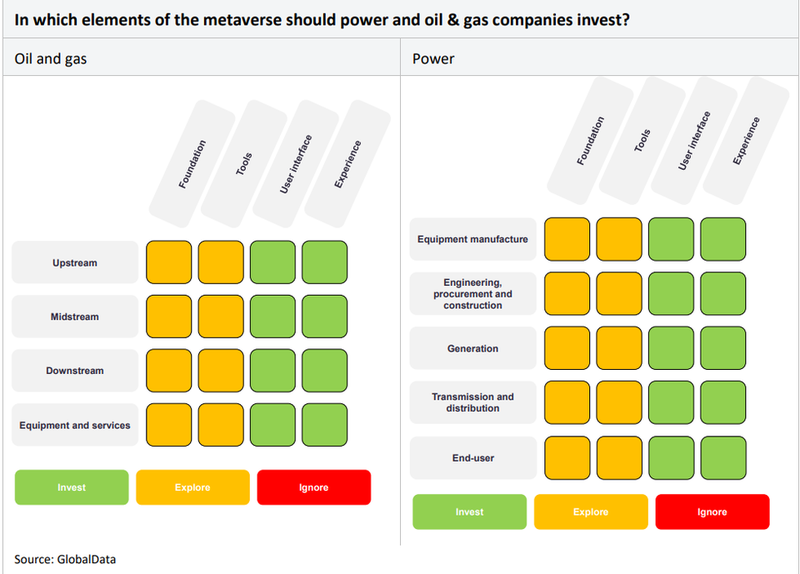The matrices below detail the areas in the metaverse where power and oil and gas companies should focus their time and resources. We suggest that energy companies invest in technologies shaded in green, explore the prospect of investing in technologies shaded in yellow, and ignore areas shaded in red.

Virtual and augmented reality headsets are contained within the user interface layer of the metaverse value chain, while digital twins are contained within the experience layer. Every layer of the power and the oil and gas value chains involves industrial assets that require maintenance and performance oversight and employees that require appropriate training to operate effectively.
Digital twins and AR-based remote assistance solutions can support the maintenance and performance requirements of industrial assets, and VR and AR can form part of the training requirements of employees. Accordingly, energy companies should adopt metaverse user interfaces and experiences throughout their operations.
Investment in the foundation and tools layers of the metaverse value chain should only be made if energy companies want to develop their own metaverse experiences rather than purchase those developed by specialist vendors. Some energy companies have chosen to develop metaverse experiences in-house. For example, EDF and Equinor have developed their own digital twins.
How the metaverse helps resolve the challenge of the energy transition
Many of the ways in which energy companies use digital twins aim to improve their sustainable credentials and support renewable energy projects. For example, Equinor uses Microsoft’s digital twin platform to create pre-development virtual versions of offshore wind farms to simplify and accelerate their physical construction. In 2021, BP also used Microsoft’s digital twin offerings to calculate the carbon emissions produced by and the energy efficiency of the Clair Ridge oil and gas facility west of Shetland. AR headsets that facilitate remote assistance can reduce carbon emissions by eliminating the need for technicians to physically travel to a site to provide support.
How the metaverse helps resolve the challenge of energy security
Industrial metaverse solutions can improve the resilience and efficiency of energy infrastructures, from oil rig machinery to substations. Optimising the performance of these assets and preventing unplanned downtime is the key to delivering a reliable energy supply. Digital twins enable the predictive maintenance, remote operation, and performance monitoring of energy assets and can also simulate hypothetical conditions and scenarios. Outfitting field engineers with AR-based remote assistance solutions can expedite maintenance operations.
How the metaverse helps resolve the challenge of industry consolidation
Overall, the metaverse can do little to resolve this challenge. On the one hand, digital twins can and are used to plan and simulate new energy infrastructure. For example, Equinor has used Microsoft’s industrial metaverse platform to virtually design new offshore wind farms to optimise the cost efficiency of their physical construction. On the other hand, even the most cleverly planned offshore wind farm is enormously expensive to construct, often costing hundreds of millions of dollars.
Moreover, adopting metaverse technologies does nothing to resolve the geopolitical challenges energy companies have to navigate. Nor can the competitive edge these technologies provide enable a newcomer to compete with incumbent energy giants.
Indeed, digital twins can potentially exacerbate industry consolidation by expediting large mergers and acquisitions within the energy industry. If both the acquirer and issuer have digital twins of their infrastructures, it is easier to analyse at the deal discussion stage the cost and revenue synergies of operating both infrastructures together. It is also easier to identify the best way to integrate both operations once the deal has been agreed.
How the metaverse helps resolve the challenge of a lack of innovation
Industrial metaverse solutions can guide an energy company’s innovation strategy. A digital twin’s data-based insights can inform how industrial processes should be altered and which systems need replacing. Incorporating metaverse technologies into energy operations will naturally require workforces to acclimate slowly to new working methods.
Nonetheless, the metaverse experiences typically deployed in the energy sector are often designed to be as user-friendly as possible. A digital twin of a facility or asset often presents insights with the aid of a 3D model rather than simply filling a dashboard with charts and written figures. This means the user can understand the asset more intuitively. VR-based training is a way to train employees in as immersive an environment as possible, expediting training processes.
GlobalData, the leading provider of industry intelligence, provided the underlying data, research, and analysis used to produce this article.
GlobalData’s Thematic Intelligence uses proprietary data, research, and analysis to provide a forward-looking perspective on the key themes that will shape the future of the world’s largest industries and the organisations within them.